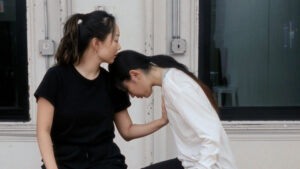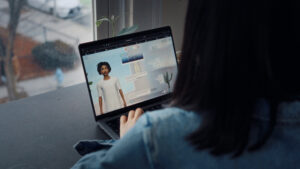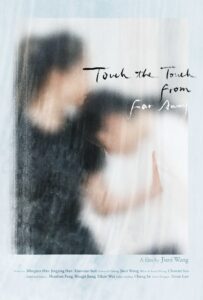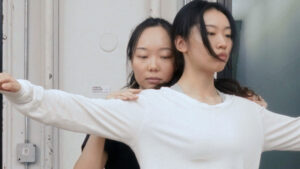An Interview with Jiani Wang: Jiani is an independent filmmaker with a lot of passion for filmwriting and direction.
What inspired you to pursue a career in film directing, writing, and producing?
I’ve loved reading and writing since I was a child. I remember whenever I was on the road in the car, I would point at every billboard we passed and ask my parents what all the words meant. Throughout my childhood and adolescence, I wrote in journals, kept a blog, and contributed to student newspapers. Since college, I’ve been working as a freelance writer for magazines and online media platforms.
Most of my published work has been nonfiction — exhibition reviews and interviews. It was through filmmaking that I found a path into fiction. I began write and think fictionally more frequently after I started making films.
Can you share a pivotal moment in your life that significantly influenced your artistic vision?
I think the process of making Touch the Touch, from Far Away marked a significant step in my creative journey. I had the opportunity to experiment with different filmmaking approaches and to work with materials that were new to me at the time, such as using still photos to build a scene, inserting archival found footage into the narrative, and weaving fictional and nonfictional scenes together into a coherent story. The process was both fun and fruitful; it allowed me to explore many ideas I had never tried before, and I also learned tremendously from it.
How has your background in photography and visual arts shaped your approach to filmmaking?
Canon AE-1 film camera that my best friend gave me as a gift. I fell into it quickly, shooting roll after roll of mostly street photography. As someone who loved watching films, loved storytelling and had been writing since childhood, I soon realized that taking static photos alone couldn’t fulfill my desire to create something more “wholesome” and “sensual” — something that combined sound, music, movement, and narrative. That was the moment I decided to dive into moving images.
I majored in Urban Design and Social Science at the London School of Economics, where I collaborated with many architects, and later spent a year working in an architectural studio. These experiences expanded my imagination from two-dimensional to three-dimensional thinking and profoundly exposed me to sculpture, installation, and land art. This is why spatial design and installation often find their way into my work, such as in Houchang Village: A Bubble City, a video installation I created in collaboration with an architect.

What does your creative process look like when developing a film project?
Each project has a very distinctive process. Before considering any other factors, I always ask myself again and again: “Why do you want to make this project? What is the core concept or message you want to explore or convey through it?” I only feel ready to start when I am certain about the answer.
How do you select the themes and subjects you want to explore in your work?
I don’t select themes and subjects. They come and find me.
What role do emotions play in your storytelling, particularly regarding the concept of “in-transition”?
Emotion is the essential driver of my storytelling. It matters more to me than any other element in a project.
Can you elaborate on the significance of the title “Touch the Touch, From Far Away”?
It touches on some of the key themes of my film: distance, the physical and the virtual, and the tactile connection within an intimate relationship. I also like how poetic it feels. I’m really fond of it.
What challenges did you face while blending documentary and fiction in your film?
One of the biggest challenges was balancing the dual perspectives: me as the director, and me as the protagonist. It was difficult to maintain enough distance to shape the narrative clearly, while also staying honest and vulnerable in front of the camera. At times, it felt like I was constantly shifting between observer and subject, which was both creatively rich and emotionally taxing.
Another challenge, in terms of the film’s structure, was figuring out how to weave the two storylines together—and how to integrate other types of footage, including archival material and screen recordings, in a way that felt smooth and coherent.
How did you approach the collaboration with choreographers and performers for your dance project?
As one who has worked with dancers and actors as a documentary photographer for multiple projects, I understand that raw, unrehearsed sparks of creativity and energy in a performance occur offstage. That’s why I chose rehearsals instead of the final performance as the main scenes for the film.
While shooting the rehearsal scene, only I as director and one of the characters knew where the plot would lead to. No script and guidelines were given prior to shooting those scenes. Instead, I would observe and record the actors’ and choreographer’s interactions, giving only minor suggestions on the rehearsal’s direction when it deviated too much from the theme.

What message do you hope audiences take away from “Touch the Touch, From Far Away”?
I wish for the film to be a quiet space where the audience can reflect on what intimacy means to them, and what kind of connection they long for in a world that often feels turbulent, distant, and divided.
Regarding how much AI chatbots can replace real human partners and provide emotional support—a question that has become increasingly pressing—instead of asking how “human” AI chatbots could potentially become, it is more important to consider, as individuals, how far we are willing to go into an “artificial intimacy,” how much tangibility, closeness, and physical touch we want to retain in our lives, and how we define love and connection today.
How do you view the relationship between humans and technology, especially in the context of communication?
The concept of this film stems from my thinking about the nature of communication and connection between humans and how developments in technology and social media influence how humans develop relationships with each other, machines, and nature.
 I became an international migrant at age 18 when I went abroad for college. Since then, I’ve traveled and lived in multiple countries and cities, generating friendships and intimate relationships with people from and in many places. During this period, I also witnessed the emergence of social media platforms such as YouTube, WeChat, Facebook, And Instagram. By tentatively, curiously, and sometimes forcefully participating in what these virtual networks enable, the range of my social network has been tremendously expanded.
I became an international migrant at age 18 when I went abroad for college. Since then, I’ve traveled and lived in multiple countries and cities, generating friendships and intimate relationships with people from and in many places. During this period, I also witnessed the emergence of social media platforms such as YouTube, WeChat, Facebook, And Instagram. By tentatively, curiously, and sometimes forcefully participating in what these virtual networks enable, the range of my social network has been tremendously expanded.
Long-distance friendships and relationships also became a part of my life because of the ‘internationally nomadic lifestyle’ our generation inhabits. That sense of distance has been reinforced repeatedly with every departure and reunion. Sometimes, I feel grateful for the smoother and closer communications that technological advances have granted us. Still, occasionally, especially when I long for physical companionship while my friends or partners are far away, I doubt if only their faces on the tiny phone screen give me an illusion of their existence and what, exactly, my emotion is attached to. As the social psychologist Sherry Turkle wrote in her phenomenal book The Second Self, ‘the building and programming of computers was the most powerful intellectual and emotional experience that changed the way human beings think about the world, about their relationships with others, and, most strikingly, about themselves.’
What are some of the most profound insights you’ve gained about human connection through your work?
I guess making this film only made me realize even more how complex the theme is, and how there are no simple definitions or easy answers to the questions surrounding it. I will continue my exploration.
How do you stay motivated and inspired in a constantly evolving artistic landscape?
It feels very natural for me to think about what I want to create next. I seldom run out of passion or ideas.
What projects or themes are you currently interested in exploring next?
I’ve just started filming a documentary about a Chinese-American woman who, after experiencing a series of hardships life threw her way, decided to become a stand-up comedian. I hope to gain some wisdom—from her story, and from the journey of making this film.
As someone who values movement and expansion in creativity, where do you envision your journey taking you in the next few years?
Keep writing, keep filming.



